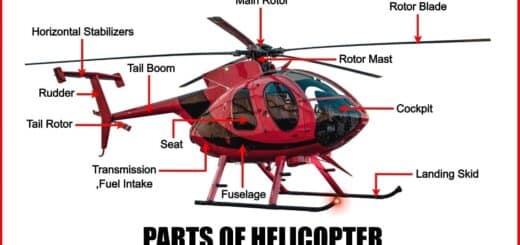9 Types of Dump Trucks and Their Uses [With Pictures & Names]
![9 Types of Dump Trucks and Their Uses [with Pictures & Names]](https://engineeringlearn.com/wp-content/uploads/2022/07/Dump-Trucks-2-1024x539.jpg)
Introduction
Types of Dump Trucks and Their Uses [with Pictures & Names]: – A dump truck is a vehicle that is utilized at construction sites to transport construction materials to and from the site. Old types of trucks were dumped manually, and presently new types of dump trucks are accessible which can undoubtedly perform the tasks through water-driven mechanisms.
Dump trucks are a significant part of our mechanized, modern life. From hauling large quantities of material to and from construction sites, street buildings, food transport, and mining, the dump truck have a significant impact on keeping the machine gear-pieces of our general public turning.
Dump trucks arrive in a scope of sizes and unload components, contingent upon the planned reason for the truck. Most dump trucks can travel typical public streets, while others are excessively huge and must be utilized onsite. ( Types of Construction Vehicles )
Types of Dump Trucks
- Standard Dump Truck
- Super Dump Truck
- Winter Weather Dump Truck
- Transfer Dump Truck
- Side Dump Truck
- Haul Dump Truck
- Semi-Truck Trailer End Dump Truck
- Semi-Truck Trailer Bottom Dump Truck
- Articulated Haul Dump Truck
1. Standard Dump Truck: ( Types of Dump Trucks )

The standard dump truck is a flexible vehicle with numerous modern industrial uses. Standard dump trucks utilize a standard truck suspension however consolidate a dump enclose mounted spot of a freight conveying cove.
The primary technique is a solitary hydraulic piston situated under the front of the dump box close to the truck cab. This piston utilizes water power to lift the front of the dump box, lower the rear of the dump box and permit the load to slide out through the rear end.
The second strategy for lifting the dump box is with a hydraulic piston mounted on one or the other side of the dump box, raising and bringing down the load. The tailgate on these dump trucks can be top-pivoted, base pivoted, or have a pressure-driven arrangement of its own that lifts the back end far removed when the load is unloaded.
Since these dump trucks utilize standard truck chassis, they are roadworthy and can move around on standard streets and highways in and around our urban communities. Standard dump trucks offer great mobility yet can’t negotiate soft soil and rough terrain conditions at large construction destinations. Thus, standard dump trucks are for the most part utilized for residential type building sites, street building, and farming type applications.
2. Super Dump Truck: ( Types of Dump Trucks )
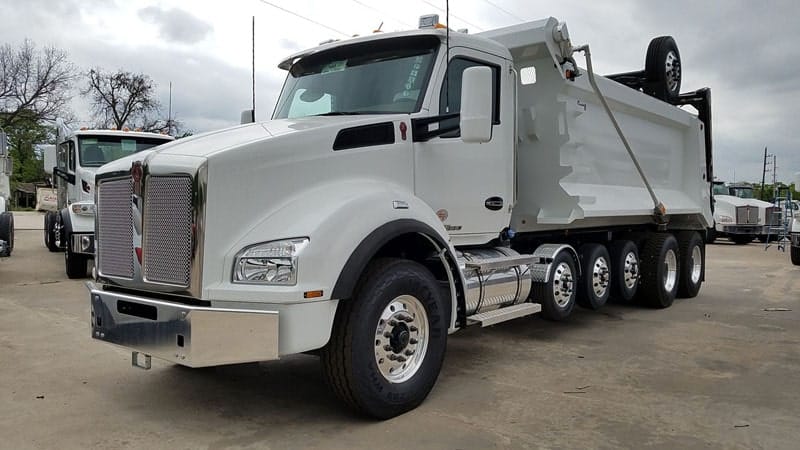
A super dump truck is a typical semi-truck trailer dump truck with an additional trailing axle toward the finish of the trailer. The extra pivot can be lifted off the road when the truck is empty, bringing down the taxes incurred for vehicles with a specific number of axles on the road. At the point when the truck is completely stacked, the trailing axle is positioned into place by a hydraulic system to stretch out further to the back of the trailer and connect with the street.
This spreads the truck’s heap over a more prominent region, increasing the legal conveying capacity of these trucks. This increases their payload capacity per trip and hence benefits per load. The additional conveying capacity of these trucks has prompted them to be termed super dump trucks.
3. Winter Weather Dump Truck: ( Types of Dump Trucks )
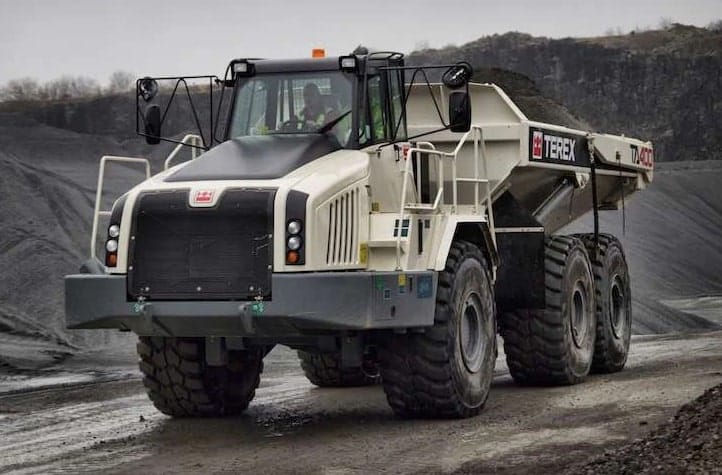
Locations that experience Heavy or weighty snowfalls in wilt consistently utilize dump trucks as snow-clearing vehicles. These are standard, substantial dump trucks that have been changed for working within this limit.
A snowplow blade (sharp edge) is fitted to the front of the truck to drive snow over the road. The dump box can pass a heap utilized to adjust the truck when it pushes a heavy or weighty load of snow at the front. The dump box can likewise be utilized to convey salt, which is spread on the roadways to forestall ice formation on the surface.
4. Transfer Dump Truck: ( Types of Dump Trucks )
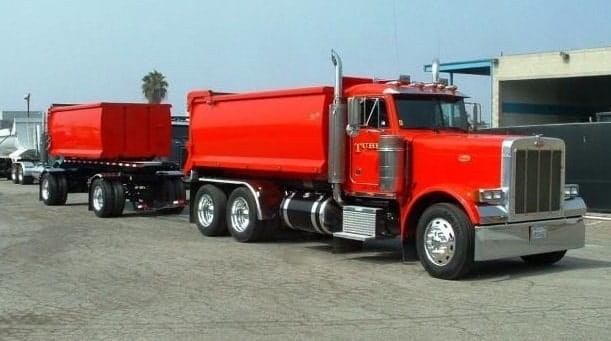
A Transfer dump truck is a standard dump truck with a changed or modified dump box. The transfer dump truck can move a heap or load box from an uncommonly designed trailer into its own dump box. The load or heap box from the trailer moves forward on its own chassis on rails and into the truck’s dump box. The trailer load bay is secured in the truck’s dump box and shipped to the dumpsite by the truck. The trailer can be left in its ongoing location while the truck moves the load to the new area or location.
The dump truck can elevate its dump box, with the trailer freight box secured inside, and dump the items at the required area or location. The trailer cargo box can then be returned to the trailer and moved out of the dump truck back onto the trailer chassis.
A variety of the transfer dump truck is the truck and the pup, with the difference being that the trailer, or the pup, has its own pressure-driven framework, permitting the trailer to self-unload whenever required. These trucks are totally based on standard truck chassis, making them fit for working on normal roads and expressways around towns and urban communities.
5. Side Dump Truck: ( Types of Dump Trucks )
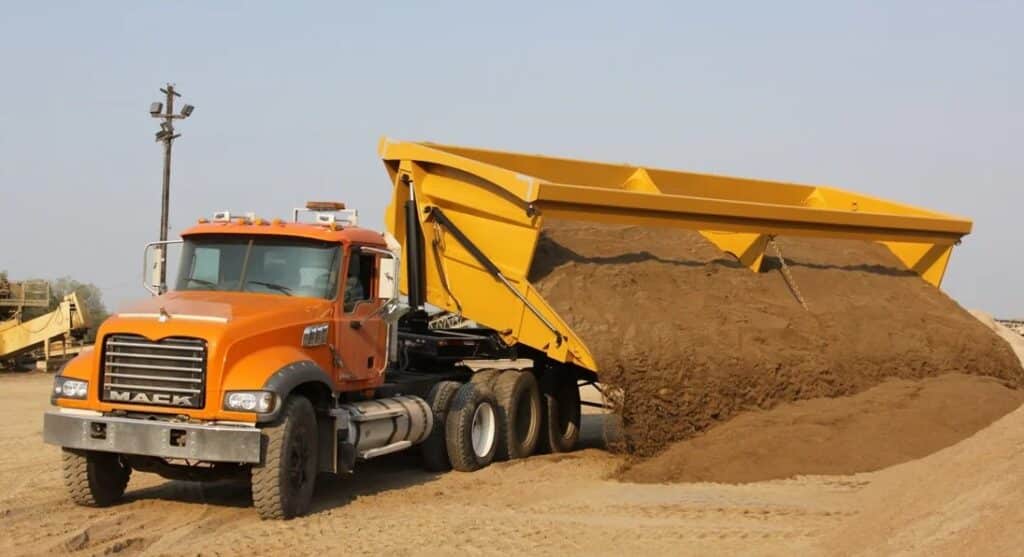
Side dump trucks give the choice to unloading the load out the side of the dump box. There are different configurations for the dumping mechanism for these trucks.
These trucks are normally semi-truck and trailer combinations, with the dumping mechanism being incorporated into the trailer as opposed to depending on the truck. Side dump trucks frequently pull different side dump trailers to expand how much freight hauled in one trip.
Side dump trucks are equipped or furnished with a hydralic mechanism at the front and back of the dump box, which rotates the dump box on its mid-line axis. This action tilts the dump box aside, emptying the freight over the side of the box.
This mechanism can normally turn the dump box to the left or the right, permitting the landfill box to be purged on one or the other side of the trailer.
Side dump trucks don’t have this issue, yet a side dump trailer is inclined to spilling in the event that the offloading is halted prematurely. The load should likewise be saved at the right point to keep the heap from falling around the trailer’s wheels. Side dump trucks can convey heavy or weighty loads, and the offloading mechanism is a lot quicker than end dump trucks, taking into consideration a quicker circle back for these trucks.
6. Haul Dump Truck: ( Types of Dump Trucks )

Haul dump trucks are extremely huge, fit for hauling between 40 tons and 400 tons of material per load. The limit or breaking point of the load will depend upon the size of the truck. Most haul dump trucks are twin axles; however, the larger versions can have up to 3 axles.
These Heavy-duty haulers are not intended or planned for use on public roads because of their size and are limited to onsite utilization as it were.
Haul dump trucks can have two offloading mechanisms. The primary type is the customary hydraulic front lift of the dump box, shifting the dump box for the load to fall out the back.
The subsequent strategy is a rear-eject mechanism. This technique has a push plate within the front surface of the dump box. At the point when activated by the hydraulics, this plate moves towards the rear of the landfill box, ejecting the load from the rear of the truck.
7. Semi-Truck Trailer End Dump Truck: ( Types of Dump Trucks )

Semi-truck trailer blends can likewise be configured to be utilized as dump trucks. These vehicles have standard semi-trucks as the hauling power, yet the trailer is the modified part of the combination with the dumping capability.
The end dump implies the freight is dumped from the trailer’s backside. The length of these trailers and the massive loads they convey require an extremely strong hydraulic piston at the front of the trailer to lift the front end and dump the freight.
The size of the piston makes for a great sight while lifting the dump box to remove the freight, however, its length additionally implies it can easily suffer damage.
operators of these trucks need to practice care to not damage the hydraulic piston while offloading. Assuming the dump box is over-burden, has an unevenly dispersed load, or is offloaded on lopsided ground, the hydraulic piston could twist, damaging the lifting mechanism. Assuming that the truck is unbalanced during the offloading process, the whole truck can overturn.
The semi-truck dump truck is useful for the large loads that can be moved or transported and on the grounds that the truck can navigate normal streets and highways.
These dump trucks are not suitable for rough terrain or delicate ground construction sites since the trailers don’t have drive wheels to help the truck in these circumstances.
8. Semi-Truck Trailer Bottom Dump Truck: ( Types of Dump Trucks )
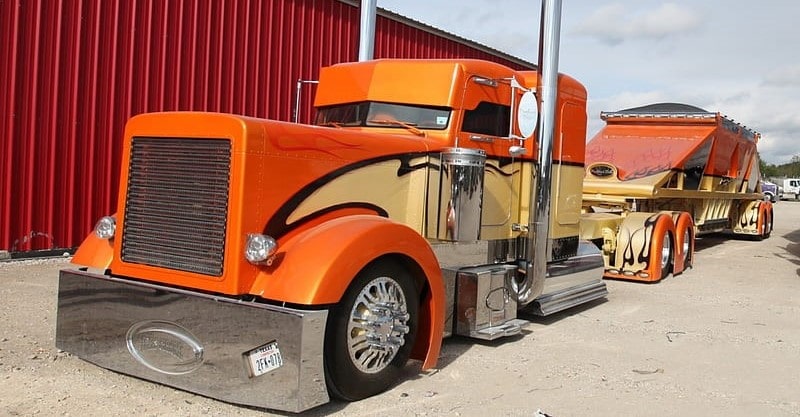
A semi-truck trailer bottom dump truck has a near setup to the semi-truck trailer end dump truck, yet the trailer has a substitute shape and offloading procedure. Bottom or Base dump trucks are likewise called belly dump trucks since the freight is dumped from the base or girth of the dump box. ( Types of Semi-Trucks )
The shape of the dump box is vital to the bottom dump mechanism to ensure the whole load is dumped with close to no cargo remaining inside the dump box. The slanting sides of the dump box to the center lower some portion of the landfill box are alluded to as a clamshell plan.
Exactly when the lower portion of the clamshell is opened, the load is put away directly under the dump box. This dump method permits the truck to drive forward, keeping the load in a line where it is required.
These dump trucks are much of the time used to transport cereal grains for farming or food creation yet can moreover convey sand for development.
9. Articulated Haul Dump Truck: ( Types of Dump Trucks )
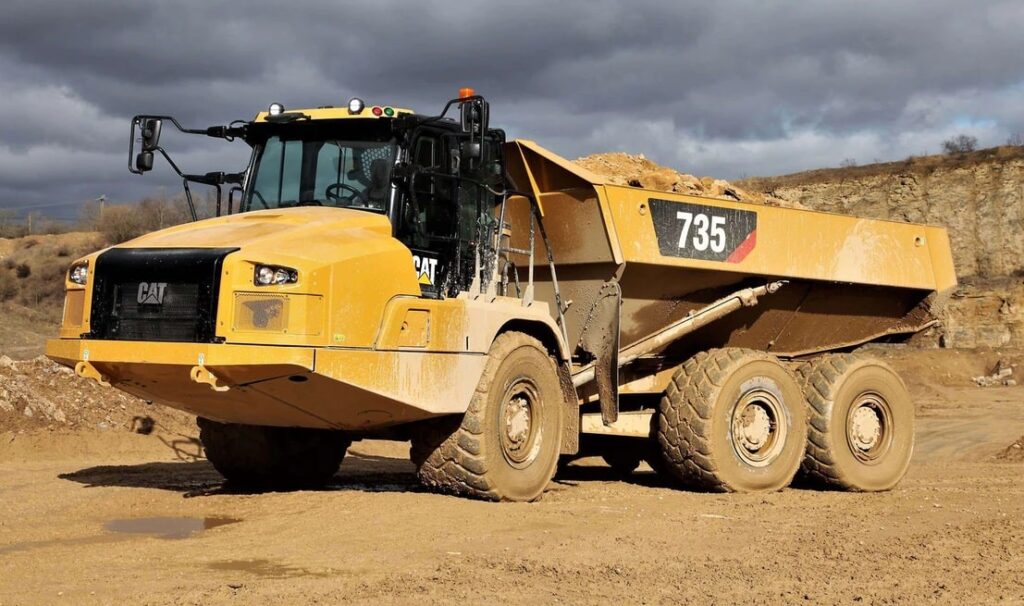
Advantages of Dump Trucks
1. The Perfect Truck Bed
One of the most distinctive features of dump trucks is their extensive dump bed. Ideal for Carrying construction trash or other loose objects, this bed permits drivers to pull a wide range of materials securely. You never need to stress over your load spilling into the street, and the bed’s water-powered lift system makes it simple to dump materials where they need to go.
2. Power
While certain vehicles may not work as proficiently with a heavy load, dump trucks are explicitly designed to work under extreme working circumstances, providing drivers with all-out control. The power take-off system included in modern dump trucks gives huge solidarity to the truck’s lift system, guaranteeing that regardless of how a heavy load you might have, your truck will actually want to deal with the weight.
3. Design Options
Dump trucks come in an extensive variety of design options to better suit the requirements of varying projects. For instance, while many small dump trucks are somewhat like flatbed trucks, large dump trucks commonly come furnished with more axels, a more extensive scope of dumping options, and joint additions to give better control and an expanded scope of development. Regardless of what size truck you want, there is a choice that can fit your precise venture needs.
Conclusion
Dump trucks hold interest for many vehicle fans because of their occasionally impressive size and flexibility in hauling large freight volumes.
The innovation and engineering applied to these vehicles to facilitate the offloading process can be ingenious in itself to create vehicles for task-specific dumping.
Dump trucks are significant vehicles that assist with driving our mining, industrial, and construction sectors. They work with effective and quicker development of materials for use in these essential areas supporting our society.
There are many types and varieties of dump trucks, each following a generally similar design but with unique features relying upon the kind of industry the truck is intended for. The capacity of the loads these trucks can move and effectively offload permits construction, horticulture, and mining to keep up with the ever-increasing demands for quicker turnarounds.
Content Source: – lemonbin, connect2local
Image Source: – linkedin, superdumps, grofftractor, larsentoubro, alibaba, peakpx, equipmentworld


